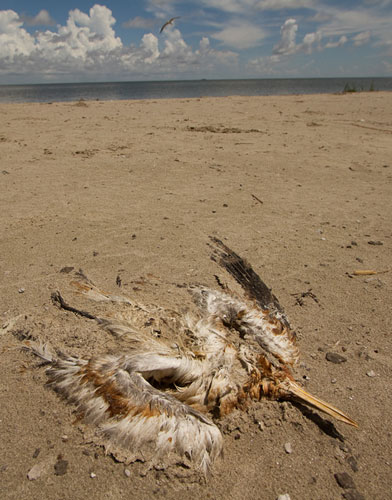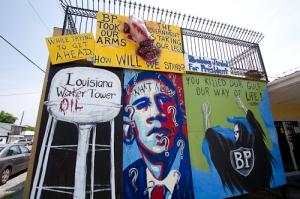
Dead Royal Tern stained with oil on beach at Raccoon Island four months after BP Deepwater Horizon oil disaster, Gulf Coast Louisiana. Photo© Gerry Ellis/Audubon/Minden Pictures
This past week the National Commission on the BP Deepwater Horizon Oil Spill and Offshore Drilling released an interlaced series of four documents, its preliminary findings on the handling of the BP oil spill (they still refuse to call it a disaster). Despite being a ‘draft’ the Commission made it clear it does not intend to spare the administration as it prepares its final report on the accident, to be delivered to the White House early next year. In part the report said,
“By initially underestimating the amount of oil flow and then, at the end of the summer, appearing to underestimate the amount of oil remaining in the Gulf, the federal government created the impression that it was either not fully competent to handle the spill or not fully candid with the American people about the scope of the problem,”
If anyone is listening, or reading, those seem like potentially extremely harsh words. The question is – IS anyone listening or reading?
In part that criticism calls into question the Administration’s ability, or inability, to listen to itself, especially the part of itself that should have known what actually was happening in this disaster.
NOAA, the National Oceanic and Atmospheric Administration, the one government agency that seem to have some immediate clue to the pending disaster according to the report (hours after BP’s rig sank on April 22nd, a white board in NOAA’s “war room” in Seattle displays the administration’s initial, worst-case scenario of the pending disaster — 64,000 to 110,000 barrels a day. See my blog Un-embedded Journalism), wanted to make public some of its worst-case models and requested approval from the Office of Management and Budget (I still am not clear about that bureaucratic chain of command?). That request was denied.
According to the Administration officials defending their actions, they said the NOAA report was a “flawed and an incomplete study” and that they sent it back to the agency for more analysis. But for god sakes they issued the report almost immediately, the well head was just beginning a four-month spewing of crude, of course it was incomplete! – but was it flawed? In political speak that means ‘we did not like what you said or said in your report, please revise if you want us to use it.’
That typifies the whole Gulf mess I have run headlong into over the past couple months – you can have access as long as we tell you what you will create images of and what you will say with those images and words afterwards. I’m no Edward R. Murrow, but that reeks of manipulation, cover up, and just plain lying.
Along the Gulf Coast things are beginning to quiet down, this mess seems to have only lodged in the short-term memory of many, soon digging for answers will be easier and harder. Easier because all the BP beach bouncers will be gone and the local parish sheriffs won’t care, I’ll have access to just about anywhere I want to go. Much harder because most of the evidence will be microscopic, maybe molecular, maybe only memory, and few folks can see that closely, or care to.
Telling people I am working in the Gulf always raises the same first question, “How bad is it really?” The question is asked with a tone of curiosity and skepticism. People do want to know and most are certain they were lied to by everyone involved in this disaster. I’m surrounded by folks that from afar want to blame BP, that’s easy. Disasters like Katrina are hard, we can’t sue Nature and we’re not sure where the CEO lives. This disaster came with a focus – a giant corporation we blindly, dogmatically want to hate. The embodiment of all big things we feel unjustly control our lives. This is especially true in the current economic and political climate in America where blaming powers seen as bigger than us is the easy out. I’ve yet to meet anyone who takes personal responsibility for this oil disaster. Anyone who stands there and says, “ya know, my way of life caused this – and I’m the one who should be paying the price.”
Wading through the post-disaster bayou of the Gulf it’s not so clear, and I’m not fully confident the National Commission on the BP Deepwater Horizon Oil Spill and Offshore Drilling will reach the real truth, that lies outside the deadline of their need to finish this report in January 2011. It’s also a quagmire more toxic than the oil and dispersants they are investigating. Passageways of politics and petroleum trail off in every direction in the bayou. As I have written previously, this whole oil disaster has made me very cautious about placing blame. I don’t place the blame squarely on BP or oil and gas company’s. Are they at fault, partially, of course. One only has to scan Barataria Bay south to the Gulf horizon and realize it is an industry that has chronically neglected its wake – ‘get the gas, suck up the oil, then move on’ is clearly the mantra. But as the report suggests, the Administration, this one (they could indicted past as well), has been incompetent. My concern is worse, they were complicit obstructionist. Journalists were never allowed to do their jobs.
The longer I work in the Gulf I’m less concerned in blame and more focused on why I don’t have a government that works? I need a government that is fully competent and fully candid to deal with situation like this disaster – corporation never will – and that in part relies on letting journalists be journalists. Unfortunately, being fully candid and competent is not something politicians have ever shown enormous capacity, therefore we need journalists, we will die without them. If one reads between the lines of this report’s criticism you will find a the problem was journalists obstructed.
Of all the report’s segments, perhaps the one most worth following is The Use of Surface and Subsea Dispersants During the BP Deepwater Horizon Oil Spill. If there is a smoking gun to a future environmental fallout from this disaster I, and a number of scientists far smarter than I, believe it is here, in the lingering dispersants (chiefly COREXIT) sprayed and injected without full scientific testing. As Deep Throat might have whispered on an abandoned shrimp dock, ‘follow the dispersants’.
If you don’t care to plow through commission draft reports (I understand wanting to wait until it’s out on Blue-ray) then here are a couple of cliffnote versions –
From the New York Times:
Report Slams Administration for Underestimating Gulf Spill
And from the Christian Science Monitor:
Oil spill report sketches anatomy of a flawed US response in Gulf
What the Commission and this Report continue to fail in pointing out with weighted vigor is that a potential toxic brew continues to infect the Gulf and its food chain, and the weight of the U.S. Government’s resources, including its access to a wealth of brilliant scientists and researchers at non-governmental institutions, is not being adequately summoned into action. For one moment pretend this is a “war” as the President and others were so politically excited to call it. A war like in Afghanistan. Then where are the troops (those scientists and researchers)?
So Where Are We Now?

In the first months after the disaster anger and frustration was well illustrated along the Gulf and across the country, now both are weathering into silence.
The Commission solidly draws a bright red line around the BP oil disaster bull’s-eye, the only problem that red line encompasses the entire Gulf and political tides inside the D.C. beltway. The contradictions well-head continue to spew from this disaster and the White House seems less capable of plugging this well-head than they were the Macondo (BP) version. Just over a week ago a government-sponsored expedition of scientists searching for leaked oil in the Gulf of Mexico reported that, more than halfway into the 10-day voyage, testing has not yet produced evidence of oil either in underwater plumes or embedded in sediment. The Gulf is a big place I understand, but where in the hell are you looking? How is it I can drive to a parking lot on Grand Isle, Louisiana, walk a half mile out to the beach and dig a couple of inches in the sand and turn up buckets of the stuff, and an entire expedition can’t produce evidence?
It appears the government needs more dispersant to make this problem go away. Thus far the expedition’s conclusion contradicts recent reports by several independent, non-governmental research expeditions that have multiple efforts finding oil in the water column close to the BP (Macondo) well and further afield.
Journalism Affected By Dispersants?
In and effort to draw some kind of frame around this picture I read a lot, scientific and journalistic, ideally by both government and non-government sources. What is astounding and frustrating is the number of dead-end stories and reports. Perhaps they’re not dead-end, they’re coming, someone is out there tolling to eventually tell, but I’m impatient. On the other hand I get the sense that everything becomes a one-off.
For example, CSMonitor.com (which has reported consistently and well on the spill) ran a story on August 24 entitled, Gulf oil spill to blame for oily blobs in vital Gulf sea life? In part it said, referring to hydrocarbons found in planktonic blue crab larvae,
Blue crabs are an important commercial species accounting for nearly $300 million in economic activity in Louisiana alone. Oil inside blue crab larvae could mean a disruption of the fishing industry. It could also be a worrying sign that the spill is affecting the reproductive cycles of a number of plankton species at the base of the Gulf’s food web.
“Since almost Day 1 of the spill, there have been grave concerns about how plankton life in the Gulf will be affected,” says Robert Thomas, director of the Center for Environmental Communications at Loyola University. “Answers to those questions could mean a lot to the future of the Gulf, and the public is dealing with a lot of speculation these days.”
The article also quoted a marine biologist Tulane University, Dr. Erin Grey, who is working on the problem. It said in late May Dr. Grey discovered oily orange droplets inside blue crab larvae she collected in areas affected by the BP oil spill. Going on to quote Dr. Grey saying, “Eighty percent of crab larvae samples collected from an area of the Gulf stretching from Louisiana to Florida showed evidence of the orange substance, which initially tested positive for hydrocarbons,”
So??? What’s happening?? That was over a month ago, where’s the follow-up story? The National Commission on the BP Deepwater Horizon Oil Spill and Offshore Drilling won’t answer that. The Answer? We could use a few more journalists on the front lines.
